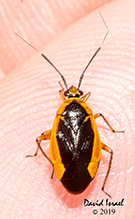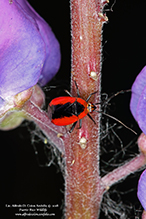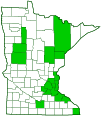plant bug
(Metriorrhynchomiris dislocatus)
Conservation • Description • Habitat • Ecology • Distribution • Taxonomy
Conservation Status |
|
|||||||
| IUCN Red List | not listed |
|||||||
| NatureServe | not listed |
|||||||
| Minnesota | not listed |
|||||||
Description |
||
Metriorrhynchomiris dislocatus is a relatively small true bug but a medium-sized to large plant bug. It occurs in the United States east of the Great Plains and in adjacent Canadian provinces. It is common in woodlands where it is found on on a variety of flowering plants. In Minnesota, it has been recorded on common false Solomon’s seal and wild geranium. The body is soft, and about ¼″ long. The head is shorter than the prothorax. There are two large compound eyes and no simple eyes (ocelli). The beak-like part of the head containing the mouth parts (rostrum) has four segments. It is short, stout, and projects downward and forward when sucking plant juices. The antennae have four segments beyond the short basal segment (scape). They are thin and long, much longer than the head and as long as the entire thickened wing covers (hemelytra). The first segment is entirely black, the second segment is black except for a short pale base, and the third and fourth segments are entirely pale. The pronotum is wider than long. There are two pairs of wings, and they are held flat over the body when at rest. Between and at the wing bases there is a triangular plate (scutellum). The front wings (hemelytra) are longer than the hind wings. The hemelytra have a thickened part at the base and a thin membranous part at the tip with a clear dividing line between the two. The thickened basal part is comprised of a narrow area (clavus) behind the scutellum when the wings are closed, and the remaining broad marginal area (corium). At the end of the corium there is a small but distinct triangular area (cuneus). The scutellum is large and triangular. The membranous tip has two closed cells. The hind wing is completely thin and membranous. The coloration is highly variable, with fifteen different color forms recorded. The color forms are not geographically separated and are considered an example of color polymorphism, not subspecies. Generally, the head, the thoracic shield (pronotum), and the leathery wing covers (hemelytra) are shiny black. Most individuals have colorful markings, either bright red or bright orange. These include the head, the lateral margins of the pronotum, and the lateral margins of the elytra. Some individuals are entirely orange except for the membranous tips of the hemelytra, which are always black. Some individuals are entirely black. The legs either match the bright coloration of the body or are mostly or entirely black. The end part of the leg (tarsus), corresponding to the foot, has 3 segments. |
||
Size |
||
Total length: ¼″ (6.5 mm) average |
||
Similar Species |
||
Habitat |
||
Woodlands |
||
Ecology |
||
Season |
||
June to mid-July |
||
Behavior |
||
|
||
Life Cycle |
||
|
||
Nymph Food |
||
|
||
Adult Food |
||
|
||
Distribution |
||||
|
Sources |
|||
| 9/9/2022 | ||||
Occurrence |
||||
Common |
||||
Taxonomy |
|||
Order |
Hemiptera (True bugs, Hoppers, Aphids, and Allies) | ||
Suborder |
Heteroptera (True Bugs) | ||
Infraorder |
Cimicomorpha | ||
Superfamily |
Miroidea | ||
Family |
Miridae (Plant Bugs) | ||
Subfamily |
Mirinae | ||
Tribe |
Mirini | ||
| Genus | Metriorrhynchomiris | ||
Synonyms |
|||
Metriorrhynchomiris affinis Poecilocapsus affinis |
|||
Common Names |
|||
This species has no common name. The common name for the family Miridae is plant bugs, and it is applied here for convenience. |
|||
Glossary
Hemelytron
The forewing of true bugs (order Hemiptera), thickened at the base and membranous at the tip. Plural: hemelytra.
Ocellus
Simple eye; an eye with a single lens. Plural: ocelli.
Pronotum
The exoskeletal plate on the upper side of the first segment of the thorax of an insect.
Scape
In plants: An erect, leafless stalk growing from the rootstock and supporting a flower or a flower cluster. In insects: The basal segment of the antenna.
Tarsus
On insects, the last two to five subdivisions of the leg, attached to the tibia; the foot. On spiders, the last segment of the leg. Plural: tarsi.
Visitor Photos |
|||||
Share your photo of this insect. |
|||||
| This button not working for you? Simply email us at info@MinnesotaSeasons.com. Attach one or more photos and, if you like, a caption. |
|||||
David Israel |
|||||
 |
|||||
Alfredo Colon |
|||||
 |
|||||
MinnesotaSeasons.com Photos |
|||||
|
|||||

Slideshows |
||

Visitor Videos |
|||
Share your video of this insect. |
|||
| This button not working for you? Simply email us at info@MinnesotaSeasons.com. Attach a video, a YouTube link, or a cloud storage link. |
|||
Other Videos |
|||


Created: 7/4/2019
Last Updated:


